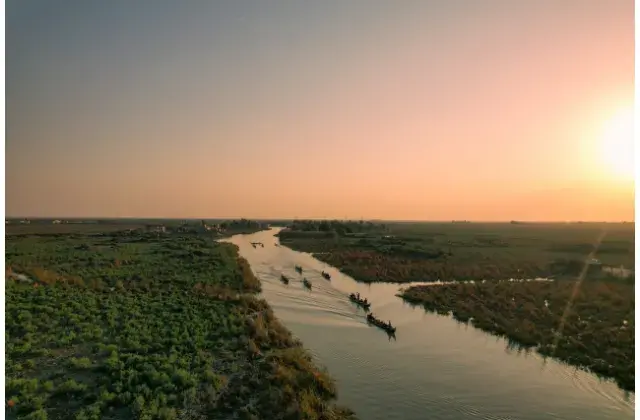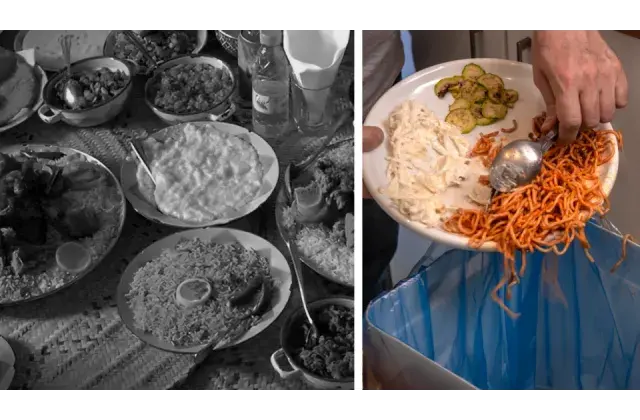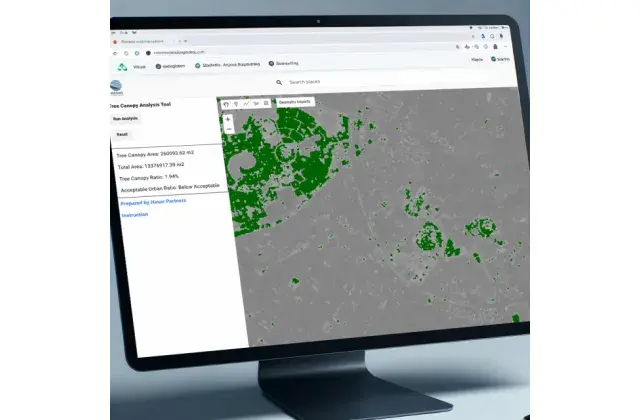A massive dust storm has forced millions of Iraqis to make emergency adjustments to their rites of life, causing thousands of them to be hospitalized for asphyxiation.
Projects on Paper: Iraq Unable to Cope with 300 Days of Dust Annually
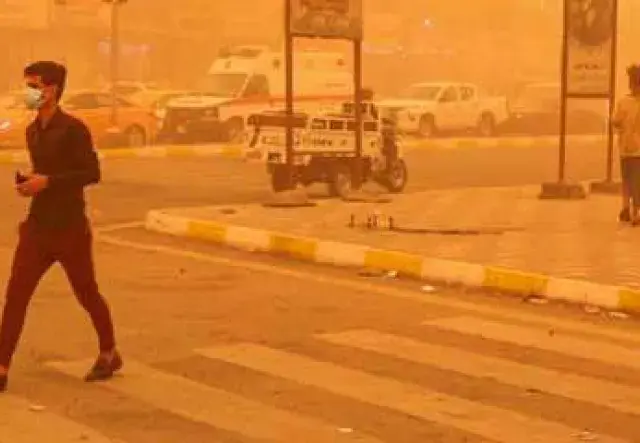
Iraq has included desertification in section 15 of its 2015-2030 strategic plan, seven years later there has been no indication that consecutive Iraqi governments have seriously considered implementing projects to combat it.
On Monday, May 16, 2022, a massive dust storm forced millions of Iraqis to make emergency adjustments to their rites of life, causing thousands to be hospitalized for asphyxiation.
Visibility declined sharply and traffic accidents occurred in different parts of the country. The Ministry of Education and the Ministry of Higher Education and Scientific Research were forced to suspend school and university attendance, and local governments in seven central and southern provinces suspended public institutions except hospitals.
The aviation authorities postponed flights scheduled for that day to and from Baghdad, Najaf and Sulaimaniyah international airports, while road transport moved very slowly, until the dust cleared, leaving its desert mark everywhere.
Successive dust storms almost occur daily hitting most parts of Iraq. The Environment Ministry has estimated 272 storms per year due to the worsening phenomenon of desertification, after years of drought caused by heavy rains and the state’s failure to develop emergency programs to save shrinking vegetation year after year, experts say.
Experts also stated that consecutive Iraqi governments have been unable to take any productive diplomatic action to counter Turkey’s water policy, and its control over the supplies in the Tigris and Euphrates rivers, which originate from its territory, with dams it has built on them, threatening to dry them up.
The successive Iraqi governments also ignored popular calls for a stance toward Iran, which has cut the flow of water through all tributaries entering Iraq through its territory. They also didn’t allocate funds to complete major strategic projects, such as the Al Jazeera irrigation project in the west of the country, nor even showed any interest in creating green belts to protect cities from sand invasion.
As a result, dust storms have become a reality for most of the year, while springs drained, streams dried, and water bodies have disappeared, such as the Red Lake in Diyala province, north of Baghdad.
About 300 storms will hit the country every year. Who can stop them?
The Director General of the Technical Department at the Ministry of Environment, Issa al-Fayyad, complained about the lack of financial allocations and water resources to curb dust storms, which he said will reach 300 per year by 2055.
In response, Ministry of Agriculture spokesman Hamid al-Nayef stated that Iraq needs to plant at least 15 billion trees to be able to counter the problem of vegetation reduction and shrinking cultivated areas.
In fact, the number of 15 billion trees is considered by some an exaggerated number, as the academic specialized in agriculture, Dr. Salah Hossam, believes that “5% of it is sufficient to plant trees in the western regions of the country, in order to fend off dust and improve the environment of the place.” However, according to Dr. Hossam, this requires the adoption of a national program with an enormous public budget and in which all government institutions take part.
Iraq ranks 181st in the world in terms of the proportion of forests for the country’s total area, at 1.9 percent, he said. This is a very low proportion, he stated, for a country where two rivers run.
When we asked the Ministry of Agriculture about its role in afforestation, we found that it only granted perennial trees to the official body requesting them and nothing else. It turned out that the issue of afforestation and the green belt in the provinces was entrusted to their local governments and had nothing to do with the Ministry of Agriculture or any other ministry.
Agricultural expert Luqman Mustafa doubts the ability of local governments in the provinces to rely on themselves in implementing projects to combat desertification. According to him, the funds that are supposed to be allocated to similar projects exceed the financing potential of the provinces, which originally complain about the lack of annual funds they receive to carry out projects in different sectors, some of which have been disrupted for years because of the insufficient funds allocated to them or because of corruption, which he says is widespread.
Luqman adds that certain areas of Iraq such as Nineveh were originally suffering from infrastructure destroyed by the 2016-2017 war on ISIS and have been waiting for nearly five years to receive adequate funds to rebuild their public facilities, whose ruins are still visible.
“The issue of creating a green belt, for example, might not be a necessity for a simple citizen suffering from unemployment and poverty because he is primarily thinking about providing food and shelter to his family” the agricultural expert said.
And what attests to the veracity of his point of view is that a group of mobile vegetable vendors in Ramadi, had covered their faces with their hoods and were only visible from the eyes to repel a dust storm that suddenly swallowed them.
One of them, Hazem Fawzan, said that he did not approve of any public project promised by the state, because “if it is implemented, it will be with bad specifications and the money that was spent on it or stolen in its name, will be wasted, and so we, the poor people, deserve it more.”
The rest supported him with a unified voice, “yes, it’s true” and another, Farqed Idris, said, “This dust is the anger of God on us…” Then, after a coughing fit, he pointed to the sky and said, “God is taking revenge on us because we allowed politicians to rob us, and we are still encouraging them every four years by electing them.”
In Kirkuk, the roofs of buildings, vehicles, and sidewalks were covered with a layer of dust, while its density obscured visibility on the roads throughout Monday, June 16, 2022.
In the old city market, Kamal Luqman parked his taxi by the road, yet he wore a mask and wrapped a wet towel around his neck, started the two windshield wipers and pointed to the traces of dirt that had formed on both sides of the glass from the outside:
“We spent our life among the smoke of the oil fields, and now the dust storms.”
He lifted his mask up slightly, and said with some irony, “We used it for coronavirus, and now for dust, both of them are killer viruses.”
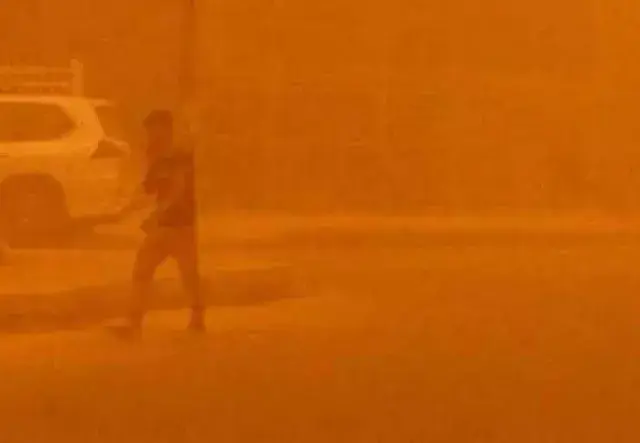
Desertification and Sandstorms
Dr. Yusuf al-Achaykar differentiates between desertification and sandstorms saying “the first can be stopped and the second is impossible to stop”, and points out that every sandy land in the world adjacent to muddy land will expand on it over time if we do not enact protection and isolation measures.
Like many others, he thinks that green belts on the edge of deserts are the best solution to halt the spread of desertification and protect fertile agricultural land, as well as improving scenery, moisturizing the atmosphere, increasing oxygen levels and preventing some light sandstorms.
As for dust storms, he says, “They are not prevented by green belts or by the afforestation of houses, nor by the rest of the funny solutions that amateurs here and there suggest to us.”
He clarifies that the dust storms are a geological environmental climate phenomenon that transcend borders and continents. They come at high altitudes as a giant wall and run over hundreds of kilometers and cannot be repelled either by trees or by a belt. And they depend on the amount of rain falling in an area each season.
The less rain in desert and sand areas, the more likely sandstorms are to form. “We also do not control the amount of rain falling on our deserts and on the deserts of neighboring countries, so we certainly cannot control or even anticipate dust storms coming to us.” “As we received the lowest rainfall in 40 years in Iraq and the region, it is not surprising that today we have experienced the largest number of storms marked in our memory.”

Readiness and Adaptation
Dr. Yusuf comments on those who say that the desert can be planted and made green by saying “It is impossible to grow and plant the desert for a simple reason other than the huge cost and which is how and where do you get water to irrigate plants?”
“Let’s say we planted and irrigated all the Iraqi desert, so what about the desert of our neighboring countries? The deserts of Africa give off some storms that reach our cities and our region.”
So, what is the solution to counter sandstorms? Al- Achaykar responds with the words “readiness and adaptation” by developing early forecasting methods, identifying the storm trajectories and its severity, and newscasting them. And also, through the development of indoor air insulation systems to prevent dust from entering as much as possible, and the preparation of hospitals and emergency services for accompanying asphyxiation, and by informing airports and passengers to be prepared earlier. Moreover, it is necessary to spread traffic awareness about driving in times of sandstorms, close some of the most dangerous streets, highways and intersections, and alert members of the armed forces, particularly at remote and isolated locations for caution purposes. “That’s just what can be done,” he concludes.
Failed Afforestation Projects
Iraq’s climate and environmental experts should conduct more specialized research to analyze and study the overall situation of dust storms sweeping the country and the causes of their formation, researcher Dr. Ahid al-Hammami said.
Analysis and interpretation should rely mainly on satellite imagery and frequent weather data published at different times of the year, especially since this data is reportedly available free of charge in the American satellite archives (Landsat) as well as in the European satellite archives (Sentinel).
As dust storms continued to increase at the beginning of the 2022 spring season, Nineveh Governor Najm al-Jubouri appeared in a televised statement confirming his request to Mosul’s mayor, Engineer Abdul Sattar al-Habbo, to impose the planting of one tree or more on anyone building a residential house in Mosul.
This statement was met with the disdain of some specialists who considered what the governor said as merely a marketing campaign that will not produce tangible practical results. The agricultural engineer Jaafar Qasim Mohieddin said, it is good to oblige citizens to plant trees, but he wondered “how many houses are built in Mosul within the course of one year?”
“Let’s suppose, although the estimated number is exaggerated, there are 1,000 houses built in Mosul per year, which means planting 2,000 seedlings. If everyone is required to plant two seedlings, we will need 10 years to plant 20,000 trees, while the speed of sand encroachment in western and southern Nineveh is estimated at five to ten kilometers per year,” he said.
He also indicated that he has been an eyewitness to many afforestation projects in Mosul over the past 10 years, through campaigns launched by Mosul municipality or voluntary organizations to plant tree seedlings on the central islands of the main streets.
However, there were no trace of these trees shortly afterwards, “either they were not watered or they were overrun by the citizens and herders who roamed the streets of the city with their cattle,” he said.
Mohiuddin suggests that local administrations in the provinces encourage citizens to plant trees in their home gardens or on the sidewalks of their homes, in exchange for financial incentives, by deducting 5- or even 10-percent of water or electric charges, so that citizens will take care of their plants and not neglect them, as government agencies have done with thousands of seedlings that never grew.
Although Iraq has included desertification in section 15 of its 2015-2030 strategic plan, seven years later, there has been no indication that consecutive Iraqi governments have seriously considered implementing projects to combat it.
According to analysts and followers of political and economic issues, this is due to other priorities, related to services and health. However, according to them, addressing desertification will lead to an agricultural recovery and a livestock boom, which means jump-starting the economy and reducing dependence on imported agricultural and animal products.
Even the initiatives undertaken by some provinces to create a green belt to protect them from the sand invasion have failed and squandered the significant funds allocated to them, including a project that was supposed to surround Karbala by 70 kilometers long and 100 meters wide. But what has been executed since 2016, is only slightly over 50-percent of the project.

National Project
In our research for potential, practical, and viable national plans and projects in place to save Iraq from the imminent threat of desertification, we found that the former Minister of Water Resources, Dr. Hassan al-Janabi, had prepared a project proposal called the Green National Belt, describing it as the first line of defense to resist sand encroachment and stop its expansion west of the Euphrates River.
The project is supposed to take between 5 to 10 years to be executed and is divided into stages from north of Mosul to southern Basra, approximately 1,000 km long, 1 to 5 km wide, and consisting of a vegetation cover formed by fruitful and fruitless trees and grass growing in a hot environment.
Janabi estimated the need for his project to plant 220 million trees at a cost of more than USD 1 billion, and various irrigation systems to cover the entire area at a cost of between USD 600 billion and USD 1.5 billion.
He also indicated that about USD 22 million are also needed for the construction of 10 housing complexes for workers, operators, and others, and for the provision of electricity to irrigation systems – in addition to that, other funds are also needed to open and pave new roads, as well as for land acquisition, drilling of wells, and desalination.
According to Janabi, the funds should be allocated from provincial development budgets in the provinces where the belt will be extended, and through foreign investments, international loans, and grants – and the Government should develop a special ministry or body, whose task is to oversee the execution of the project, communicate with state agencies, and conclude contracts with them.
Janabi believes that his project will effectively help halt sand encroachment, prevent its access to the Iraqi depth, protect the fertility of the land of Mesopotamia, increase agricultural production, stop environmental degradation, and protect biodiversity threatened by climate change and global warming; in addition to creating jobs for thousands of Iraqi citizens from different provinces, jump-starting the national economy, creating a state of collective solidarity to accomplish it, supporting potential scientific research, developing capacities in the fields of renewable energy and environment and engineering, opening up investment opportunities in Iraq, benefiting from successful global experiences in the field of operation, combating desertification, providing marketing, management, coordination, and export, preventing diseases caused by dust storms to the population, reducing pressure on national hospitals and clinics, and providing treatment costs.
Water Harvesting
Professor Dr. Marwan Miteb Al Sayed has also developed a project that would, according to him, save Iraq from drought and desertification, spread greenness, provide prosperity to all regions, make a qualitative shift in agriculture, and promote food and water security.
His project is based on the construction of 200 small dams along the Tigris and Euphrates River, to take advantage of the waters of its lakes in agriculture, industry, tourism, housing, and climate, and that would lead to optimal exploitation in the cultivation of flood plains (surrounding the rivers of half a million dunams, with very fertile soils and abundant water) and to a successful planting of fruits, vegetables, and medicinal herbs as Professor Marwan hopes.
Moreover, according to Professor Marwan, the execution of the project is also based on the use of smart irrigation methods; the provision of sustainable housing, energy infrastructure, roads, health and educational services in these plains; the establishment of a network of heavy water drainage pipes, and treatment plants at housing sites in the flood plains and near dams; and the construction of small and large technological plants for agricultural manufacturing – canning, drying, freezing and pharmaceutical manufacturing – in these plains near dams: and the development of fisheries through the construction of fish-growing lakes near these dams and the use of modern technology in the breeding and exploitation of livestock in their lakes.
He says these dams will also meet the requirements of harvesting rainwater in Iraq, because all the valleys and their streamlets throughout Iraq pour their water into the branches and rivers of the Tigris and Euphrates, creating “renewable, enormous and inexhaustible water resources collected in these dams that spread along and across Iraq and do not go to the Gulf region, especially in rainy years.”
In addition, he adds that water can be drawn from these dams to the eastern and western branches of the two rivers to cover the area of Iraq, including the island, and the Western Sahara, using giant and branched pipes to irrigate strategic crops such as wheat, barley, corn, fruits, and vegetables, as unfiltered water with legalized and intelligent cultivation.
Water is also pumped from all lakes through a giant pipe network to all Iraqi villages and districts, and filtering and purification plants are installed for human and animal consumption.
According to him, this will maximize groundwater resources, improve soil and climate, eliminate dust waves and dust storms by planting millions of trees and forests on the island and barren areas and eliminating desertification.
Professor Marwan believes that his revolutionary project is better than the construction of large dams that cost the Iraqi state hundreds of millions of dollars, in addition to similar post-operation costs and water injection of foundations – as they cause changes in water properties, increase humidity and waste large amounts of water due to evaporation.
In addition to that, large dams are “vulnerable to earthquakes and kinetic cracks that may affect the dam’s body and turn the soil of the after-dam river into a salty one that is not useful for agriculture, and that cause the flood of entire villages and displace their inhabitants when they are established.”
Island Irrigation Project
Plans and proposals may remain a dead letter, but there are major strategic projects in Iraq that were approved under the previous regime, to which funds were allocated and were partly implemented, however, although after 2003 some countries provided loans and grants to complete them, its completion never happened.
The most important of these was the launch of the Al Jazeera irrigation project west of Nineveh province that is considered one of the most important irrigation projects, not only in Iraq, but also in the Arab region and the Middle East in about a year.
The project consists of three parts or sections (north, east and south) whose waters are secured from the Lake of the Mosul Dam project on the Tigris River in northern Iraq (35 km north of Mosul) and was supposed to cover an area of more than 750,000 dunams at 250,000 dunum per part (one dunum according to Iraqi legislation is equivalent to 2,500 square meters).
According to Nineveh Water Resources director Qusay Mohammed, the northern section of the port covers Rabia and Tal Afar districts in the west, and south reaches al-Hadar and Qayyara districts south of Mosul, while the eastern area covers the Nineveh Plain, The Taliif and Hamdania districts, and Bashiqa district to the southeast of Mosul toward Kirkuk province.
He said that the project began in the 1980s and was stalled by the repercussions of the 1991 Second Gulf War and the nearly 12-year international sanctions imposed on Iraq.
“If executed, the shape of Nineveh will change, drought and desertification will be eliminated, and dead land will be transformed into green meadows bringing economic, security, social, tourism and environmental benefits to all of Iraq,” says the director of Nineveh Water Resources.
“The only part that has been partially executed and is currently operating at less than half its capacity, is the Northern Project Section,” he noted with regret.
Although the work resumed after 2003, its completion was interrupted again during ISIS’s control of Mosul and other Iraqi cities between 2014 and 2017 and fighting during that period severely damaged the stations and the project’s branch networks.
After achieving the liberation war of Nineveh from ISIS, the Iraqi Ministry of Water Resources, with the support of international organizations, notably the Food and Agriculture Organization of the United Nations (FAO), began restoring the first phase of the Northern Section project, which feeds 100,000 dunums.
Work is under way to restore and operate the second phase of the same section with an area of 100,000 dunums as well, and director Qusay expects to complete it during 2023, pointing out that the third phase will cover an area of 40,000 dunums and work would be initiated as soon as the second phase is completed.
Successive dust storms hit most parts of Iraq, with the Ministry of Environment estimating 272 storms per year, due to the worsening phenomenon of desertification, after years of drought, heavy rains, and the state’s failure to develop emergency programs to save the shrinking vegetation year after year.
Eastern Section
According to officials from the Ministry of Water Resources, the eastern section of the project may be launched in the second half of 2022.
Khaled al-Hassou, an engineer who is responsible for the supervision of the Eastern Island Irrigation Project, said the project feeds from Mosul Dam Lake to the north and will cover 250,000 dunums and extend to the Nineveh plain areas (Tlakeif, Bashiqa, Hamdania, Bartala and Al-Namrod) ending in the village of Al-Adliya near al-Zab, southeast of Mosul.
A total length of 82 km “on lands that are classified as very good and excellent, which means that agricultural production will be at a very high level,” he said.
In October 2009, the Ministry of Water Resources signed a contract with a Turkish company to execute the eastern part of the al-Jazeera irrigation project, but work has been halted due to ISIS’s control of the area in 2014, and no phase of the project has since been completed.
Accordding to al-Hassou, the duration of the completion of the eastern section of the island irrigation project depends on the availability of funding, and if full funds are allocated to cover the costs of its completion, the work is expected to take five to six years. He further noted the importance of the project as it will contribute to transforming Mosul into an agricultural and tourist area,and create thousands of job opportunities during and after execution.
We tried to find answers to many questions pertaining to the southern part or section of the South Island Irrigation Project, which is considered the most important, because if completed, it will protect many regions such as Kadai, Baaj, Hadar and Tel A’abba districts (western and southern Nineveh) from desertification.
The project will end the sands invasion and dust storms once and for all, cover the country’s need for grains (wheat and barley) and even turn them, according to Nineveh agriculture officials, into a source of grains and several varieties of vegetables and fruits.
However, we did not find that any plans had been adopted for its completion, and what had taken place was just a discussion held every now and then in the Ministry of Water Resources, but without any concrete action because there were no financial allocations.
A ministry employee told us, asking not to reveal his name, that the eastern section was a priority for the ministry and a number of its stages (the pumping station and the feeding channel) were supposed to be completed with funding from a Japanese loan after signing an agreement in 2009.
The latest on the project, however, is that a Japanese consultant named Sanyo has revised its economic feasibility and that lengthy meetings and discussions took place between the Ministry of Water Resources, the Ministry of Agriculture, and the Ministry of Planning with the aim to develop designs forthe project, but its execution did not materialize due to the security events in Nineveh and its fall to ISIS in June 2014.
Inside his apartment in Salhia, Baghdad, Sheikh Ayed Hammoud, a 72-year-old man, is voluntarily quarantined due to chronic asthma, which is exacerbated in a way that threatens his life if he goes out at the time of a dust storm. “Desertification forced me to leave the land of my parents and grandparents in Nineveh, and then the terrorists forced me to leave the province, and the dust forced me to stay here like a prisoner,” he says with deep sorrow.
Authors: Saif Al-Obaidi and Nineveh Investigative Team
Organisation: NIRIJ - Network of Iraqi Reporters for Investigative Journalism




